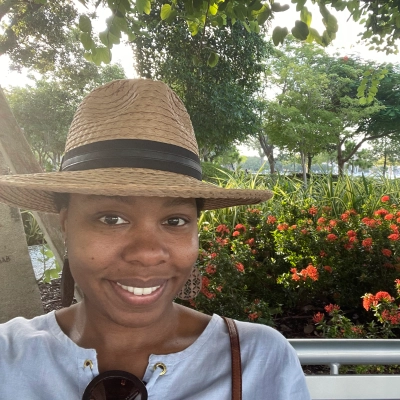Balancing a demanding career with a healthy personal life can be challenging, but it’s not impossible. We asked industry experts to share how they maintain a positive work-life balance, especially in a demanding or fast-paced career. Discover the strategies and boundaries they have found to be effective, so you can create a more fulfilling and sustainable lifestyle.
- Start Your Day with a Clear Task
- Protect Personal Time as Non-Negotiable
- Define and Stick to Working Hours
- Build Intentional Rhythms into Each Day
- Align Work with Personal Values
- Prioritize Tasks and Delegate Effectively
- Structure Your Day for Optimal Performance
- Create Sacred Spaces for Rest
- Cultivate Hobbies Outside of Work
- Design Recovery into Your Routine
- Prioritize Self-Care and Rest Periods
- Establish Clear Boundaries and Communicate Them
- Set Office Hours and Take Time Off
- Practice Mindfulness Through Yoga
- Invest in Quality Sleep for Better Balance
- Schedule Self-Care as a Business Priority
- Treat Personal Wellness as a Critical Function
17 Tips for Work-Life Balance in Demanding Careers
Start Your Day with a Clear Task
I maintain a positive work-life balance by not starting my workday in the morning until I know exactly what task I am going to work on. This strategy is very effective because if I don’t know what I want to work on, then it’s very easy to waste time, waste the whole day, and burn out working a lot of hours. I also time-block my calendar for all activities.
 Valerie Martinelli, MPA
Valerie Martinelli, MPA
CEO & Career Leadership Coach, Valerie Martinelli Consulting, LLC
Protect Personal Time as Non-Negotiable
In a fast-paced, high-performance world, work-life balance isn’t something you find — it’s something you fiercely protect. I learned this the hard way in my early years, when hustle culture convinced me that rest was a weakness and burnout was a badge of honor. Spoiler: it’s not.
What changed everything for me was flipping the script. Instead of trying to “fit in” life around work, I started treating my personal time as non-negotiable — just like a client meeting or board presentation. I literally block out space in my calendar for workouts, quiet mornings, date nights, and even 30-minute tech-free mental resets. If it’s not scheduled, it doesn’t exist. This one boundary has been the biggest game-changer.
Another shift? I stopped romanticizing being “always on.” Now, I have clear end-of-day rituals — close the laptop, shut off Slack notifications, go for a walk — and I communicate those boundaries openly. What surprised me is that my clients and team didn’t push back; they respected it. And it gave them permission to set their own boundaries too.
One personal strategy I love is what I call the “energy audit.” Every quarter, I sit down and ask: what parts of my schedule give me energy, and what parts drain it? Then I ruthlessly delegate, automate, or eliminate the stuff that doesn’t light me up. It keeps me aligned with what matters most — and that clarity is what keeps me from getting buried in busywork that doesn’t move the needle.
The truth is, balance isn’t about doing less — it’s about doing the right things with intention. And when you lead with that mindset, you don’t just perform better at work — you show up better in life. That’s not just success; that’s sustainability.
 John Mac
John Mac
Serial Entrepreneur, UNIBATT
Define and Stick to Working Hours
Here are some strategies that can help maintain a positive work-life balance in a fast-paced working environment:
1. Clearly define working hours and stick to the schedule. This ensures you don’t get burned out.
2. Use modern tools and technologies to automate repetitive tasks.
3. Prioritize work based on deadlines so you do not feel overwhelmed.
4. Block specific periods of time on the calendar for breaks.
5. Dedicate specific hours a day for catching up on work and planning ahead.
 Susan Snipes
Susan Snipes
Head of People, Remote People
Build Intentional Rhythms into Each Day
Finding balance when you’re running multiple brands and raising a toddler means building intentional rhythms into every day. I start each morning with a 45-minute “family first” block — breakfast, playtime, and a quick walk with my son — before opening my laptop. That clear boundary ensures I’m fully present at home and fuels me for work. During office hours, I batch client calls into back-to-back blocks (usually late morning) so I can reserve afternoons for deep-focus tasks — such as strategy sessions, writing, or content planning — without interruptions.
I also have a strict “device curfew” at 7 p.m.: no email, no Slack, no screens. Even if something urgent arises, I flag it and address it on the next workday. To reset midday, I take a five-minute walk outside — small pauses that preserve my creativity. At the end of each day, I spend two minutes writing tomorrow’s top three priorities, then close my computer and transition into family time with a brief gratitude practice. These simple boundaries — morning family rituals, focused work blocks, micro-breaks, and a firm shutdown routine — turn the constant juggle of PR, branding, and parenting into a sustainable, positive rhythm.
 Kristin Marquet
Kristin Marquet
Founder & Creative Director, Marquet Media
Align Work with Personal Values
In today’s always-on culture, maintaining work-life balance can feel more like a myth than a manageable goal — especially in fast-paced industries. We coach clients who are juggling demanding roles, caregiving, creative pursuits, and everything in between. Many come to us after burnout, believing that balance is impossible in their career. But here’s the truth: balance isn’t about doing less — it’s about being intentional with what you do.
A positive work-life balance isn’t a perfect 50/50 split. It’s a dynamic alignment between your personal values, energy levels, and professional responsibilities. In demanding careers, this balance requires active boundary-setting and realistic prioritization — not just good time management. Here are some of the most effective strategies we teach and practice:
Time-block your energy, not just your hours. Know when you’re most productive and schedule high-focus tasks during that window. Save admin work for low-energy periods.
Implement “tech curfews.” Set boundaries around work devices — turn off email alerts after hours, create separate logins, or use app blockers.
Negotiate flexibility proactively. Even in fast-paced environments, many leaders are open to customized schedules if you’re clear about your deliverables.
Take Justin, a product manager in a hyper-growth tech startup. He came to us drained, working 70-hour weeks. Through coaching, we restructured his workflow using “batching” (grouping similar tasks), and he introduced “silent Thursdays” — a no-meeting day for deep focus. He also communicated clear boundaries with his team around response times. Within three months, Justin reduced his working hours by 20% without sacrificing performance — and finally started sleeping again.
A 2023 report from McKinsey Health Institute emphasized that employees with high-quality boundaries were 47% more likely to report good mental health and 32% more likely to feel engaged at work. Meanwhile, Gallup’s “State of the Global Workplace” (2024) revealed that employees who intentionally disconnect outside work hours have 23% higher well-being scores.
Work-life balance isn’t about achieving perfection — it’s about designing your days to reflect your priorities. In fast-paced roles, this takes intention, communication, and sometimes, courageous recalibration. We help ambitious professionals set boundaries that protect their energy without compromising their impact.
 Miriam Groom
Miriam Groom
CEO,
Mindful Career Counselling Inc., Mindful Career Coaching
Prioritize Tasks and Delegate Effectively
Maintaining work-life balance in the fast-paced 3PL industry isn’t just good advice — it’s a business necessity. As someone who’s built multiple companies while raising a family, I’ve learned this lesson through both success and struggle.
When I started my company, I was constantly juggling product development, marketing, and fundraising. The logistics industry is notorious for its 24/7 demands — shipments don’t stop for weekends or holidays. I quickly realized that without intentional boundaries, work would consume everything.
My approach has evolved significantly, especially since becoming a parent. Seeing data that showed how our hours with children peak in their early years was a powerful reminder that while we chase many forms of success, these moments are perhaps our most valuable currency.
Here’s what works for me:
First, I implement ruthless prioritization. I’ve narrowed my weekly focus to three areas: customer-centric innovation (5-7 hours speaking directly with eCommerce brands), building high-leverage systems (creating consistent evaluation processes), and strategic network cultivation. Everything else gets delegated or scheduled.
Second, I leverage technology while setting firm boundaries around it. In logistics, issues arise at all hours, but I’ve configured notification systems to filter what truly needs immediate attention versus what can wait until morning.
Third, I practice what we preach to our 3PL partners — specialization over generalization. The “riches are in the niches” professionally, but this applies personally too. I’d rather be fully present for fewer family activities than partially present for many.
Finally, I’ve built a leadership team that complements my strengths and covers my weaknesses. My Chief of Staff manages our matchmaking team, creating space for me to focus on strategic initiatives without micromanaging operations.
The logistics industry will always be demanding, but by setting clear expectations, embracing technological efficiency, and remembering what truly matters, we can build successful businesses without sacrificing our most important relationships.
 Joe Spisak
Joe Spisak
CEO, Fulfill.com
Structure Your Day for Optimal Performance
Here are 3 strategies to maintain a positive work-life balance in a demanding or fast-paced career:
1. Maintain Strict Time Boundaries:
Set firm working hours and use tools like app blockers or “Do Not Disturb” modes to prevent work notifications outside those hours. As a result of this clear separation, personal time is protected, and the risk of burnout is reduced. For example, many developers find that turning off email and messaging alerts after work hours significantly improves their ability to disconnect and recharge.
2. Visually Manage Tasks:
Utilize methods such as the Eisenhower Matrix or Kanban boards (e.g., Trello or Jira) to categorize tasks by urgency and importance. Using this approach will help focus attention on what is truly important, preventing overwhelm and making work hours more productive. Breaking work into manageable chunks also encourages regular breaks, which refresh the mind and increase efficiency.
3. Exercise and Practice Self-Care Regularly:
Incorporate daily physical exercise and mindfulness practices into your routine. Even brief activities, such as a 20-minute walk or meditation session, can help reduce stress and improve mental clarity. Hobbies and social time outside work strengthen emotional well-being, which is crucial for sustaining long-term career success.
 Paul Raphael Gomes
Paul Raphael Gomes
Founder, Benwil Marketing Agency
Create Sacred Spaces for Rest
For me, maintaining a healthy work-life balance in a fast-paced career comes down to structure. I love creating a schedule — and more importantly, sticking to it. Blocking out time for deep work, calls, admin, and even breaks has been a game-changer. If it’s not on the calendar, it doesn’t happen.
One strategy that’s really helped is setting clear start and stop times for the day. I’m all in during work hours, but once I shut the laptop, I try to be fully present in my personal life — whether that’s going for a walk, grabbing dinner with friends, or just unplugging for a bit. I’ve also learned to treat time off the same way I treat meetings: it’s scheduled, it’s protected, and it matters. Boundaries aren’t about being rigid — they’re about making room for creativity, clarity, and longevity.
 Trevor Perkins
Trevor Perkins
Founder, PERK PR & Creative Agency
Cultivate Hobbies Outside of Work
Maintaining a positive work-life balance starts with remembering who I am outside of what I do. As someone called to both ministry and media, my schedule can move at a rapid pace, but I’ve learned that pace without peace leads to burnout. So I build my balance around intentional boundaries and rhythms, not just routines.
One key strategy is honoring sacred space. My mornings include quiet time with God before the world starts pulling on me. I also keep evenings tech-light when possible to protect my rest and relationships. Having a “no-fly zone” around certain hours or days helps me stay present and not always in work mode.
I’m also a big believer in planning for joy. That means scheduling time for movement, meaningful conversations, and moments that refill me; whether it’s a walk, a good meal, or simply being still. I work with an amazing team that respects those boundaries, which makes a huge difference.
Lastly, I give myself permission to pause. Rest is not a reward for finishing the list; it’s a requirement for doing the work well. In fast-paced spaces, balance isn’t a finish line; it’s a discipline. And the more consistent I am about honoring it, the more impactful I can be.
 Dr. Angela Butts Chester
Dr. Angela Butts Chester
Pastoral Counselor & Empowerment Coach • Media Entrepreneur • International Women’s Speaker, DR ANGELA CHESTER
Design Recovery into Your Routine
I make sure to have hobbies outside of work. I like to focus on learning to cook, doing barre exercises, and even tending to my garden. This really helps to slow me down and re-energize me for work.
 Dielle Charon
Dielle Charon
Business Coach, For the 23%
Prioritize Self-Care and Rest Periods
In a fast-paced role like mine, maintaining work-life balance isn’t about checking out — it’s about intentionally designing recovery time into the rhythm of the week. One boundary I set early on is no work-related notifications after 7 PM. That simple rule helps me shift out of “reactive mode” and be fully present with my family.
I also make use of short, structured breaks during the day — even 15 minutes outside or a quick workout resets my energy far more effectively than pushing through. On a larger scale, I treat personal time like critical meetings: it goes on the calendar and doesn’t get bumped.
The strategy that’s worked best? Treating rest and recovery as fuel for performance, not a reward for it. When you lead a team and a business, your clarity, energy, and presence are part of the company’s foundation — and balance is what sustains them.
 Evan Stone
Evan Stone
Vice President – Sales & Marketing, Relumination
Establish Clear Boundaries and Communicate Them
I prioritize my rest period. On the weekends, I prioritize rest and self-care first, and then anything for my business. I also do self-care activities that make me feel better in my body, ranging from massages and stretch lab sessions to facials.
 Jerrica Long
Jerrica Long
Storyteller Show Runner, Jerrica Says
Set Office Hours and Take Time Off
I don’t view work-life balance as a perfect split; rather, I see it as a matter of flow. In a remote startup environment, where the lines between work and home can quickly blur, the only way to protect your time is to give it structure. I adhere to set hours, log off at the same time each day, and block my calendar for everything, including breaks and deep work.
As someone managing a team of writers, I am intentional about how much we take on each week. We plan with breathing room, not just deadlines. That space allows people to do their best work without feeling stretched thin, and I strongly discourage working on weekends or days off. Rest is part of the process, not a reward for burning out.
To me, work-life harmony means being present in whatever mode you’re in, without guilt and without multitasking. When you build your days with care, you don’t have to recover from them later.
 Rashi Prasad
Rashi Prasad
Project Manager, WrittenlyHub
Practice Mindfulness Through Yoga
As a Studio Manager for creative entrepreneurs, my job is to make sure my clients can log out and actually live their lives! I use many of the strategies that I recommend in my own business, such as setting office hours, taking Fridays off, blocking out time to work on your own business, and over-communicating your boundaries to your clients. The better you share and explain your own boundaries and expectations, the better people will be able to respect them — and be inspired to bring those practices into their own lives!
 Mackenzie Iles
Mackenzie Iles
Studio Manager & Systems Specialist, Sit Studio Inc.
Invest in Quality Sleep for Better Balance
I practice Yoga in the form of Shambhavi Mahamudra Kriya.
It has been an amazing experience for me. It’s like an invisible force that keeps me up, straight, and going — no matter what! It hasn’t just helped with work-life balance; it has helped me make my life into a game.
One other thing I want to share: when I’m at work, I work. When I’m at home, I’m fully at home.
This automatically gives me balance. I don’t need to think too hard about managing it — it just flows.
 Chaitanya Sagar
Chaitanya Sagar
Founder & CEO, Perceptive Analytics
Schedule Self-Care as a Business Priority
I’m a 27-year-old founder who raised $65 million for my crypto company. I’ve had periods of my life where I really let myself go, and it impacts everything, from the quality of my work to my personal relationships. For the last year, I’ve focused on improving my health, and what I found is that sleep tracking has the highest return on investment. Wearables like the Oura Ring or Whoop have made it easy for me to ensure I get at least eight real hours of sleep every night.
 Neel Somani
Neel Somani
Founder, Eclipse Laboratories Inc.
Treat Personal Wellness as a Critical Function
Scheduling is how I maintain a positive work-life balance — and it’s non-negotiable. Here’s what I mean.
As the owner of a wellness retreat planning business, maintaining work-life balance isn’t just a goal — it’s essential to how I operate and lead by example. I view my health as a non-negotiable “business expense.” Just like paying bills before discretionary spending, I prioritize self-care before anything else. One of the most effective strategies I’ve adopted is treating personal wellness as a critical business function — not something I squeeze in when time allows.
Each week, I block time for my morning routine, meal prep, regular exercise, breaks throughout the day, and full unplug days off. These aren’t indulgences — they’re investments. Without health and clarity, productivity suffers. Ironically, the more I prioritize these non-work essentials, the more effective I am in my business. My stress levels are lower, my energy is higher, and my creativity flows more easily.
The key boundary I’ve set is simple: I don’t negotiate with my self-care time. It comes first, because I can’t serve others — whether planning retreats or growing a business — if I’m depleted. Work-life balance isn’t about achieving perfect symmetry each day; it’s about consistently prioritizing what fuels you so you can sustainably show up for the work that matters.
 Geneva Bell
Geneva Bell
Owner, You Just Pack
 Valerie Martinelli, MPA
CEO & Career Leadership Coach, Valerie Martinelli Consulting, LLC
Valerie Martinelli, MPA
CEO & Career Leadership Coach, Valerie Martinelli Consulting, LLC
 John Mac
Serial Entrepreneur, UNIBATT
John Mac
Serial Entrepreneur, UNIBATT
 Susan Snipes
Head of People, Remote People
Susan Snipes
Head of People, Remote People
 Kristin Marquet
Founder & Creative Director, Marquet Media
Kristin Marquet
Founder & Creative Director, Marquet Media
 Miriam Groom
CEO, Mindful Career Counselling Inc., Mindful Career Coaching
Miriam Groom
CEO, Mindful Career Counselling Inc., Mindful Career Coaching
 Joe Spisak
CEO, Fulfill.com
Joe Spisak
CEO, Fulfill.com
 Paul Raphael Gomes
Founder, Benwil Marketing Agency
Paul Raphael Gomes
Founder, Benwil Marketing Agency
 Trevor Perkins
Founder, PERK PR & Creative Agency
Trevor Perkins
Founder, PERK PR & Creative Agency
 Dr. Angela Butts Chester
Pastoral Counselor & Empowerment Coach • Media Entrepreneur • International Women’s Speaker, DR ANGELA CHESTER
Dr. Angela Butts Chester
Pastoral Counselor & Empowerment Coach • Media Entrepreneur • International Women’s Speaker, DR ANGELA CHESTER
 Dielle Charon
Business Coach, For the 23%
Dielle Charon
Business Coach, For the 23%
 Evan Stone
Vice President – Sales & Marketing, Relumination
Evan Stone
Vice President – Sales & Marketing, Relumination
 Jerrica Long
Storyteller Show Runner, Jerrica Says
Jerrica Long
Storyteller Show Runner, Jerrica Says
 Rashi Prasad
Project Manager, WrittenlyHub
Rashi Prasad
Project Manager, WrittenlyHub
 Mackenzie Iles
Studio Manager & Systems Specialist, Sit Studio Inc.
Mackenzie Iles
Studio Manager & Systems Specialist, Sit Studio Inc.
 Chaitanya Sagar
Founder & CEO, Perceptive Analytics
Chaitanya Sagar
Founder & CEO, Perceptive Analytics
 Neel Somani
Founder, Eclipse Laboratories Inc.
Neel Somani
Founder, Eclipse Laboratories Inc.
 Geneva Bell
Owner, You Just Pack
Geneva Bell
Owner, You Just Pack







